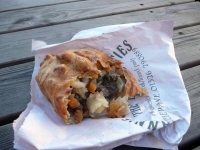It is said that you never talk of a ‘Cornish pasty’ in Cornwall. It’s always referred to simply as a pasty…
The delicious savoury parcel is a meal in itself, and doesn’t need to be accompanied by anything – other than a nice cup of tea. The vegetables within, comprising onions, potatoes and swede (called turnip in Cornwall), must be sliced. The meat, usually skirt or chuck steak, should be chopped. The filling always goes into the pasty raw, and baking takes upwards of an hour during which time the filling steams and its flavours blend together – acting to form a gravy.
Even in Cornwall there is no consensus as to what type of pastry makes the best pasty. Some say short, others that rough puff pastry is better. Both schools agree that the texture has to be firm enough to hold the filling without cracking or splitting (to be strong enough to endure being dropped down a mine shaft). Traditionally the pasty would be held by the crimped edge, which would be discarded at the end of the meal having become dirty.
The earliest references to pasties date back to the 13th Century, and they have been exported around the world in various forms – wherever Cornish people go pasties soon follow.



Good to see your post on the pasty. How did the two examples (photographed) compare when tasted? You didn’t mention the sweet end of the pasty, or is that just an urban myth?
I trust you also encountered that other famous Cornish delicacy the Saffron Bun aka Saffron Cake?
They were both very tasty, though the first one was the best – from Ann’s Famous Pasty Shop.
I have yet to find a sweet end pasty, though my quest will continue with a return trip in mid April – when I also hope to track down Cornish Fairings…
Saffron cake has now been covered – and it was quite delicious.
If you ever travel to the Isle of Wight you must try our Famous Pasties for comparison.